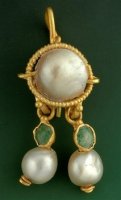
2,000-year-old gold earring found in Jerusalem
2,000-year-old gold earring found in Jerusalem
Associated Press - Israeli archeologists have discovered a 2,000-year-old gold earring beneath a parking lot next to the walls of Jerusalem's old city, the Israel Antiquities Authority said Monday.
The discovery dates back to the time of Christ, during the Roman period, said Doron Ben-Ami, director of excavation at the site. The piece was found in a Byzantine structure built several centuries after the jeweled earring was made, showing it was likely passed down through generations, he said.
The find is luxurious: A large pearl inlaid in gold with two drop pieces, each with an emerald and pearl set in gold.
"It must have belonged to someone of the elite in Jerusalem," Ben-Ami said. "Such a precious item, it couldn't be one of just ordinary people."
In a statement released Monday, the authority said the piece of jewelry was "astonishingly well-preserved." Finds from the Roman period are rare in Jerusalem, Ben-Ami said, because the city was destroyed by the Roman Empire in the first century A.D.
Shimon Gibson, an American archaeologist who was not involved in the dig, said the find was truly amazing, less because of its Roman origins than for its precious nature.
"Jewelry is hardly preserved in archaeological context in Jerusalem," he said, because precious metals were often sold or melted down during the many historic takeovers of the city.
"It adds to the visual history of Jerusalem," Gibson added, saying it brings attention to the life of women in antiquity.
Though Gibson dates the piece slightly later than the antiquities authority, to sometime between the second and fourth centuries A.D., he said its quality and beauty were impressive.
Ben-Ami added that he expects more small, luxury items to turn up in future excavations.
Earrings similar to this one have been found at archaeological sites throughout Europe, Ben-Ami said, where the Roman Empire also flourished. The authority said the earring appeared to be crafted using a technique similar to that depicted in portraits from Roman-era Egypt.
Eliane Boutros







 Gisele Aoun
Gisele Aoun
 Maroun Abboud
Maroun Abboud
 Caroline Daher
Caroline Daher
 Elie Bitar
Elie Bitar
